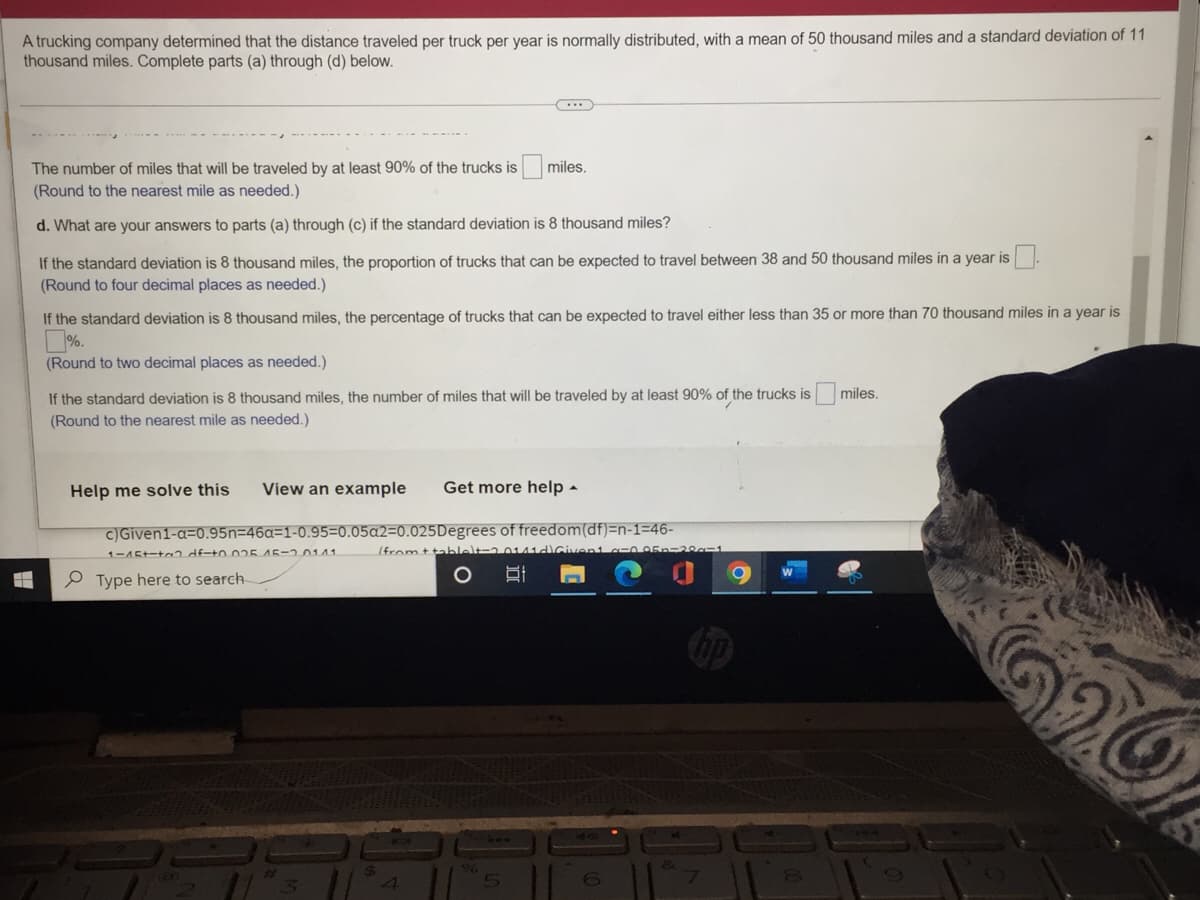A trucking company determined that the distance traveled per truck per year is normally distributed, with a mean of 50 thousand miles and a standard deviation of 11 thousand miles. Complete parts (a) through (d) below. C... a. What proportion of trucks can be expected to travel between 38 and 50 thousand miles in a year? The proportion of trucks that can be expected to travel between 38 and 50 thousand miles in a year is. (Round to four decimal places as needed.) b. What percentage of trucks can be expected to travel either less than 35 or more than 70 thousand miles in a year? The percentage of trucks that can be expected to travel either less than 35 or more than 70 thousand miles in a year is%. (Round to two decimal places as needed.) c. How many miles will be traveled by at least 90% of the trucks? The number of miles that will be traveled by at least 90% of the trucks is miles. (Round to the nearest mile as needed.)
A trucking company determined that the distance traveled per truck per year is normally distributed, with a mean of 50 thousand miles and a standard deviation of 11 thousand miles. Complete parts (a) through (d) below. C... a. What proportion of trucks can be expected to travel between 38 and 50 thousand miles in a year? The proportion of trucks that can be expected to travel between 38 and 50 thousand miles in a year is. (Round to four decimal places as needed.) b. What percentage of trucks can be expected to travel either less than 35 or more than 70 thousand miles in a year? The percentage of trucks that can be expected to travel either less than 35 or more than 70 thousand miles in a year is%. (Round to two decimal places as needed.) c. How many miles will be traveled by at least 90% of the trucks? The number of miles that will be traveled by at least 90% of the trucks is miles. (Round to the nearest mile as needed.)
Glencoe Algebra 1, Student Edition, 9780079039897, 0079039898, 2018
18th Edition
ISBN:9780079039897
Author:Carter
Publisher:Carter
Chapter10: Statistics
Section10.4: Distributions Of Data
Problem 19PFA
Related questions
Question

Transcribed Image Text:A trucking company determined that the distance traveled per truck per year is normally distributed, with a mean of 50 thousand miles and a standard deviation of 11
thousand miles. Complete parts (a) through (d) below.
(...)
The number of miles that will be traveled by at least 90% of the trucks is
miles.
(Round to the nearest mile as needed.)
d. What are your answers to parts (a) through (c) if the standard deviation is 8 thousand miles?
If the standard deviation is 8 thousand miles, the proportion of trucks that can be expected to travel between 38 and 50 thousand miles in a year is
(Round to four decimal places as needed.)
If the standard deviation is 8 thousand miles, the percentage of trucks that can be expected to travel either less than 35 or more than 70 thousand miles in a year is
%.
(Round to two decimal places as needed.)
miles.
If the standard deviation is 8 thousand miles, the number of miles that will be traveled by at least 90% of the trucks is
(Round to the nearest mile as needed.)
Help me solve this
View an example
Get more help.
c)
Given1-a=0.95n=46a-1-0.95-0.05a2=0.025
Degrees of freedom(df)=n-1=46-
1-15+-+? df-+0.025 15-2.01.11.
vep1 a=0.85p-28a-1
Type here to search
/from + table)
O
10
[
6
20

Transcribed Image Text:A trucking company determined that the distance traveled per truck per year is normally distributed, with a mean of 50 thousand miles and a standard deviation of 11
thousand miles. Complete parts (a) through (d) below.
C
a. What proportion of trucks can be expected to travel between 38 and 50 thousand miles in a year?
The proportion of trucks that can be expected to travel between 38 and 50 thousand miles in a year is
(Round to four decimal places as needed.)
b. What percentage of trucks can be expected to travel either less than 35 or more than 70 thousand miles in a year?
%.
The percentage of trucks that can be expected to travel either less than 35 or more than 70 thousand miles in a year is
(Round to two decimal places as needed.)
c. How many miles will be traveled by at least 90% of the trucks?
The number of miles that will be traveled by at least 90% of the trucks is miles.
(Round to the nearest mile as needed.)
d. What are your answers to parts (a) through (c) if the standard deviation is 8 thousand miles?
Help me lve this View an example
Get more help.
c) Given1-a=0.95n-46a-1-0.95-0.05a2=0.025 Degrees of freedom (df)=n-1-46-
1-15+-+~2.df-+0.025.15-2.0141
(from + tablelt=2.01411d)Given1 a=0
Type here to search
O 81
96
5
=
11
Expert Solution
This question has been solved!
Explore an expertly crafted, step-by-step solution for a thorough understanding of key concepts.
This is a popular solution!
Trending now
This is a popular solution!
Step by step
Solved in 2 steps with 1 images

Recommended textbooks for you

Glencoe Algebra 1, Student Edition, 9780079039897…
Algebra
ISBN:
9780079039897
Author:
Carter
Publisher:
McGraw Hill

Glencoe Algebra 1, Student Edition, 9780079039897…
Algebra
ISBN:
9780079039897
Author:
Carter
Publisher:
McGraw Hill